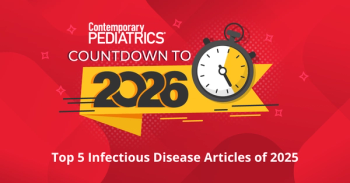
Low-dose atropine eye drops may reduce myopia progression in children
Results from the phase 3 CHAMP trial may support low-dose atropine as a pharmacological treatment option for myopia progression in children.
Low-dose atropine in concentrations of 0.01% and 0.02% (NVK002) demonstrated reduced myopia progression and axial elongation compared with placebo in children over 3 years of treatment, according to new phase 3 trial findings.1
The analysis of the Childhood Atropine for Myopia Progression (CHAMP) trial suggested the treatment effect observed with atropine 0.01%, is clinically meaningful, with an increased number of responders to therapy compared with placebo (28.5% vs 17.5%) while a smaller treatment effect was observed for atropine 0.02%.
“The clear efficacy of atropine, 0.01%, in slowing myopia progression and axial elongation may lead to less frequent or delayed changes in glasses, progression to less severe correction, and potential reduction of long-term sequelae, which could lead to vision loss later in life such as myopic maculopathy,” wrote the investigative team, led by Karla Zadnik, OD, PhD, The Ohio State University College of Optometry.
Global rates of myopia are expected to reach approximately 50% by 2050, with 938 million people projected to develop myopia with refractive error worse than –6 diopters (D) and an increased risk of major sequelae. Although options, including multifocal contact lenses and orthokeratology, are effective in slowing axial elongation and myopia progression, no pharmaceutical products are currently approved for treating childhood myopia progression.
Clinical trials, such as the Low-Concentration Atropine for Myopia Progression (LAMP) study, indicated the efficacy of atropine 0.01% in slowing myopia progression with fewer adverse effects compared with higher concentrations of atropine.2 Compounded low-dose atropine is used off-label in the US, but contains preservatives; NVK002 is a novel, preservative-free, pharmaceutical-grade atropine formulation being developed for the treatment of myopia progression.
The phase 3 randomized CHAMP trial evaluated the efficacy and safety of low-dose atropine at concentrations of 0.01% and 0.02% versus placebo to treat myopia progression in children. The 3-arm, parallel-group, double-masked trial was conducted across 27 clinical sites in North America and 5 countries in Europe from November 2017 - August 2022. Key inclusion criteria included an age of 3 to 17 years or younger at enrollment, myopic spherical equivalent refractive error (SER) of -0.50 to 6.00 D in each eye, astigmatism ≤−1.50 D in each eye, and anisometropic SER of <1.50 D.
Participants were randomly assigned in a 2:2:3 ratio to receive placebo, atropine 0.01%, or atropine 0.02%, respectively, dosed once per day in each eye at bedtime. For the primary efficacy endpoint, investigators sought to determine the proportion of participants’ eyes that showed less than 0.50 D myopia progression from baseline at month 36 for atropine 0.02% vs. placebo. Secondary efficacy outcomes were defined as the responder analysis for atropine 0.01% and change from baseline for SER and axial length for both doses at 36 months in a modified intention-to-treat population (mITT; participants 6 to 10 years of age at baseline).
Over the study period, a total of 576 participants were randomly assigned to treatment groups and 573 (mean age, 8.9 years; 312 females [54.5%]) received trial treatment and were included in the safety set. Meanwhile, the 489 children (84.9%) who were 6 to 10 years of age at randomization composed the mITT set.
The analysis showed the proportion of responder eyes was 17.5% (n = 44 of 252) in the placebo group, 28.5% (57 of 200) in the atropine 0.01% group, and 22.1% (81 of 366) in the atropine 0.02% group. At 3 years, the difference versus placebo was significant for atropine 0.01% (odds ratio [OR], 4.54; 95% CI, 1.15 - 17.97; P = .03), but was not significant for atropine 0.02% (OR, 1.77; 95% CI, 0.50 - 6.26; P = .37).
Moreover, the change in SER (least squares mean [LSM] difference) from baseline at 36 months was -1.28 D (95% CI, -1.37 to -1.19 D) in the placebo group, -1.04 D (95% CI, -1.14 to -0.94 D) in the atropine 0.01% group, and -1.18 D (95% CI, -1.26 to -1.10 D) in the atropine 0.02% group. The LSM difference for atropine 0.01% versus placebo was 0.24 D (95% CI, 0.11 - 0.37 D; P <.001), with a smaller treatment effect for atropine 0.02% (LSM difference, 0.10 D; 95% CI, -0.02 D to 0.22 D; P = .10).
For axial length, investigators found the LSM difference for atropine 0.01% vs. placebo was -0.13 mm (95% CI, -0.19 to -0.07 mm; P <.001), while it was -0.08 mm for atropine 0.02% versus placebo (95% CI, -0.13 to -0.02 mm; P = .005) at 36 months. Both doses additionally reduced axial length elongation compared with placebo at month 12 and month 24. The safety analysis revealed both low-dose atropine concentrations were safe and well-tolerated, with investigators noting similar incidences of treatment-emergent adverse events (TEAEs) in all study groups.
“The CHAMP trial results support the possibility that atropine, 0.01%, eye drops as applied in this trial may be a safe and effective pharmacologic option for individuals similar to those enrolled in this trial,” investigators wrote.
References:
- Zadnik K, Schulman E, Flitcroft I, et al. Efficacy and Safety of 0.01% and 0.02% Atropine for the Treatment of Pediatric Myopia Progression Over 3 Years: A Randomized Clinical Trial. JAMA Ophthalmol. Published online June 01, 2023. doi:10.1001/jamaophthalmol.2023.2097
- Yam JC, Jiang Y, Tang SM, et al. Low-Concentration Atropine for Myopia Progression (LAMP) study: a randomized, double-blinded, placebo-controlled trial of 0.05%, 0.025%, and 0.01% atropine eye drops in myopia control. Ophthalmology. 2019;126(1):113-124. doi:10.1016/j.ophtha.2018.05.029
Newsletter
Access practical, evidence-based guidance to support better care for our youngest patients. Join our email list for the latest clinical updates.




